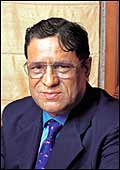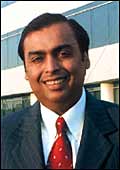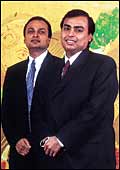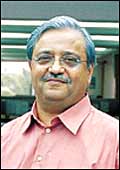|
 IPO IPO
Maruti Udyog
It may have not
been the year of the IPO, but it was the year of Maruti's (Managing
Director Jagdish Khattar, right) IPO for sure. At a time when the
current bull market rally hadn't yet quite taken off, the promoters
of India's largest car-maker-the Indian government and Suzuki Motors
of Japan-decided it was time to make a public offering. The timing
couldn't have been better, and the Maruti issue appears to have
opened the floodgates on Dalal Street.
After yielding control to Suzuki for Rs 1,000
crore, the government decided to offer 25 per cent of its holding
to the public via the book-building route. After a series of splits
from a face-value of Rs 100 to Rs 5, the floor price for the IPO
was kept at Rs 115. The issue was oversubscribed 13 times and the
government actually ended up retaining 10 per cent of that amount,
and the price rose to Rs 125. On the first day of listing, the stock
spurted 35 per cent. These days it trades in the Rs 360 range, an
appreciation of almost 300 per cent, handily outperforming even
this bull market.
-Kushan Mitra
 POLITICIAN POLITICIAN
Atal Bihari Vajpayee
If there is one
person who can walk away with the "Politician of the Year''
trophy without even a murmur of protest, it is unquestionably the
79-year-old Indian Prime Minister, Atal Bihari Vajpayee. His position
in history is already assured-as the first non-Congress leader to
complete a five-year term leading a 24-party coalition. "His
strategy of combining diplomatic repositioning, India's growing
economic clout, and military firmness has given the country a new
importance in the international league,'' says BJP President Venkaiah
Naidu.
It is the PMO that has really been driving
the reforms agenda, clearing the air whenever various ministries
have squabbled. In fact, at the 50th meeting of the National Development
Council last January, the pm not only signalled the government's
resolve to accelerate and expand reforms, but also focused on four
major development issues: poor governance, barriers to internal
trade, creating an investor-friendly climate and empowerment of
panchayats. Vajpayee's second innings has just begun.
-Ashish Gupt
M&A
Grasim-L&T Cement
 It
took its time to happen, but once it did it was certainly worth
all the effort put in by the A.V. Birla Group's experienced corporate
finance team led by CFO D.D. Rathi (above). Clearly such a think-thank
came in good use, what with the acquisition not proving easy. There
were the institutions with which Birla had to hectically negotiate
with (the FIs are the single-largest shareholders in the company).
Finally, after months of to-ing and fro-ing, the L&T management
agreed to cede control in the demerged cement company to Grasim.
This deal has helped the Birlas become the largest cement manufacturer
in India with a combined capacity of around 31 million tones per
annum. The closest competitor is the Gujarat Ambuja-ACC combine
with around 30 million tones. It
took its time to happen, but once it did it was certainly worth
all the effort put in by the A.V. Birla Group's experienced corporate
finance team led by CFO D.D. Rathi (above). Clearly such a think-thank
came in good use, what with the acquisition not proving easy. There
were the institutions with which Birla had to hectically negotiate
with (the FIs are the single-largest shareholders in the company).
Finally, after months of to-ing and fro-ing, the L&T management
agreed to cede control in the demerged cement company to Grasim.
This deal has helped the Birlas become the largest cement manufacturer
in India with a combined capacity of around 31 million tones per
annum. The closest competitor is the Gujarat Ambuja-ACC combine
with around 30 million tones.
As per the three-step demerger plan, L&T
will hive off the cement business into a separate company, Cemco,
where the parent (L&T) will hold 20 per cent. The entire process
is expected to be over by the middle of 2004. At the L&T EGM
on February 3, these demerger plans will be discussed. The tough
part, Birla will agree, is over.
-Narendra Nathan
 CEO CEO
Mukesh Ambani
Controversies,
litigation, poor connectivity, rival networks blocking calls and
messages...the odds were clearly stacked against Mukesh Ambani's
grand telecom blueprint. Despite his detractors writing off Reliance
India Mobile (RIM) in early part of 2003, the Chairman of Reliance
Industries delivered what he promised in 2002. Within 10 months
of launch, RIM has garnered a 23 per cent marketshare in the wireless
telephony market (GSM and CDMA), with the backing of 52.13 lakh
subscribers (as of November 30, 2003). RIM is adding 30,000 subscribers
each day.
There's plenty more to come: Netway, broadband
for enterprises, Reliance mobiles with cameras, pre-paid cards,
and Java Green Coffee Gourmet shops at Reliance outlets. Seems like
Ambani is poised to eat into the marketshare of GSM players in the
coming months. 2004 could well be his year too.
-Swati Prasad
BANK
HDFC Bank
 The
banking sector was doubtless one of the stronger flavours of 2003,
but few banks-private or public-can hold a candle to HDFC Bank's
quality of assets and earnings, and also its pace of growth, even
after reaching a balance sheet size of Rs 30,000 crore. Aditya Puri,
Managing Director, HDFC Bank, has plenty to be proud of: a high
and sustainable fee income, low cost of funds, a roaring cash management
system for stock exchanges and corporates, and a 35-lakh strong
customer base, 25 lakh of which are demand accounts. And every month,
Puri's adding some 1 lakh accounts. The
banking sector was doubtless one of the stronger flavours of 2003,
but few banks-private or public-can hold a candle to HDFC Bank's
quality of assets and earnings, and also its pace of growth, even
after reaching a balance sheet size of Rs 30,000 crore. Aditya Puri,
Managing Director, HDFC Bank, has plenty to be proud of: a high
and sustainable fee income, low cost of funds, a roaring cash management
system for stock exchanges and corporates, and a 35-lakh strong
customer base, 25 lakh of which are demand accounts. And every month,
Puri's adding some 1 lakh accounts.
At the same time, HDFC Bank is opening up newer
revenue streams like supply chain management for large corporates,
which allows for instant money transfer between a company and its
clients. Puri's also filled the one glaring gap that existed in
his bank's portfolio- housing finance-by tying up with parent HDFC
to market its home loan products for a commission. We could go on,
but by now you should be convinced about HDFC Bank's status as India's
No 1 bank.
 INVESTOR INVESTOR
Rakesh Jhunjhunwala
While the stockmarket
rallied through the better part of this year, Rakesh Jhunjhunwala
was driven to exasperation by persistent doubts raised by journalists
and fellow investors. "Is this rally for real", "Will
a HM/KP kind of scam send the market crashing", were some questions
he had to answer virtually every day. Jhunjhunwala saw this rally
coming way back in May 2002, when he told a pink daily: "We
are at the threshold of a structural and secular bull run...The
increase in FII investment is inevitable..." Some scoffed,
others ignored him, but a few who did believe him must have surely
raked it in. "I am happier that I stand vindicated rather than
that I made money," says R.J., who's estimated to have trebled
his investments to Rs 600 crore in the current rally.
Confident that the market will stay bullish,
Jhunjhunwala is now looking for a new home, taking up a plush 4500
sq feet office in Nariman Point, and is expanding his team from
six to 20. When the going gets good, Jhunjhunwala gets going.
-Dipayan Baishya
COMPANY
Reliance Industries
 Why
do investors love reliance so much? Is it for a) petrochem, b) oil
& gas, c) petroleum products marketing, d) telecommunications?
It's tough to choose actually from any of these businesses, some
in which the Ambanis enjoy supremacy (petrochemicals) and others
(like oil & gas and telecom) that promise to add huge new revenue
dimensions to the Reliance group. According to the company's estimates,
oil & gas could record incremental annual revenues of Rs 10,000
in three to four years. Why
do investors love reliance so much? Is it for a) petrochem, b) oil
& gas, c) petroleum products marketing, d) telecommunications?
It's tough to choose actually from any of these businesses, some
in which the Ambanis enjoy supremacy (petrochemicals) and others
(like oil & gas and telecom) that promise to add huge new revenue
dimensions to the Reliance group. According to the company's estimates,
oil & gas could record incremental annual revenues of Rs 10,000
in three to four years.
The other new businesses also appear poised
for exciting times. The Ambanis expect to have 1,500 retail outlets
for marketing petroleum products by June this year. And the most
exhilarating of projections is that Reliance Infocomm-which at one
time looked like a monumental blunder-is poised to enter the black
in its first year of operations. Small wonder then that Reliance
Industries, besides emerging as BT's Most Valuable Company, also
bagged "India's Best Managed Company" Award in mid-2003,
based on a BT-A.T. Kearney study. For India's No. 1 private sector
company with sales of $13.7 billion (Rs 63,020 crore), there are
still plenty of more chapters to be written in the Ambani growth
story.
 B-SCHOOL B-SCHOOL
IIM-A
Jerry Rao was there.
So was M.S. Banga. And K.V. Kamath. And Kishore Chaukar. N.R. Narayana
Murthy even worked there. If you haven't guessed by now, we're talking
about the hallowed Indian Institute of Management, Ahmedabad (IIM-A).
Rao, Banga, Kamath, and Chaukar are all part of the recently founded
Alumni Council of IIM-A.
But all these CEOs are creations of the past.
What is it about IIM-A that makes it tick today-and in the process
the best B-school in India, according to a BT survey? It could be
the alumni, and the faculty. And also the institute's method of
instruction. The case study format may not be unique to IIM-A, but
it's the sheer depth and intensity it injects into a case study
that makes it possible to bring it to life. Unsurprisingly then,
IIM-A tops the charts in terms of brand equity, enjoying the highest
recall amongst MBAs, wannabe MBAs, hr heads, young executives and
functional heads. Giving IIM-A a run for its money, however, is
IIM-B, which scores higher (albeit marginally) on parameters like
reputation, placement, quality of placement and faculty. But at
the end of the day, as marketers (not only those from IIM-A) will
tell you, it's the brand power that counts.
STATE FOR BUSINESS
Maharashtra
 If
Maharashtra emerged top dog, in the BT-Gallup survey of The Hottest
States For Business, it's with good reason: Superior infrastructure,
a vast pool of skilled labour, and an almost endless supply of raw
material are just three of them. But, without doubt, what also helps
Maharashtra top the charts is the relevance of Mumbai in the Indian
economic and industrial scheme of things: Most of the banks and
financial institutions are concentrated in Mumbai, the two premier
stock exchanges (the NSE and the BSE) are located in this city,
and the biggest corporate houses (Reliance, the Tatas, and the A.V.
Birla Group) are headquartered in what's still known as Bombay for
most of the city's populace. If
Maharashtra emerged top dog, in the BT-Gallup survey of The Hottest
States For Business, it's with good reason: Superior infrastructure,
a vast pool of skilled labour, and an almost endless supply of raw
material are just three of them. But, without doubt, what also helps
Maharashtra top the charts is the relevance of Mumbai in the Indian
economic and industrial scheme of things: Most of the banks and
financial institutions are concentrated in Mumbai, the two premier
stock exchanges (the NSE and the BSE) are located in this city,
and the biggest corporate houses (Reliance, the Tatas, and the A.V.
Birla Group) are headquartered in what's still known as Bombay for
most of the city's populace.
Of course, it isn't as if everything is hunky-dory
in Maharashtra. If Chief Minister Sushil Kumar Shinde wants to hold
on to his numero uno status-Andhra Pradesh and Karnataka are hot
contenders-he's got to get a grip on the security issues that plague
the state. The infrastructure too needs to be beefed up, and numerous
initiatives that have been blueprinted need to take off fast. Otherwise,
Maharashtra may soon lose its position of eminence.
 EMPLOYER EMPLOYER
P&G
As BT's best employers
in India survey reveals, it isn't necessarily the better performing,
or the higher profile, or the more aggressive companies that are
great havens for their employees to work in. Last year's No. 1 Best
Employer was Procter & Gamble (Chairman Bharat Patel, left)
a huge name in healthcare and fast-moving consumer goods globally,
but certainly not the biggest FMCG player in India (not by a long
way). But it certainly does hit the headlines for its employee-friendly
culture.
P&G hires freshers straight out of B-school,
and empowers them to build the business. For instance it isn't uncommon
for virtually fresh recruits to be put in charge of brand launches.
What also helps is that the Indian operations are a huge talent
pool for P&G worldwide, and it isn't uncommon for two and three-year-young
P&G-ITEs to be picked up by other P&G operations in the
region. So, if your goal is to become an entrepreneur manager, you
know where you should be headed.
|
